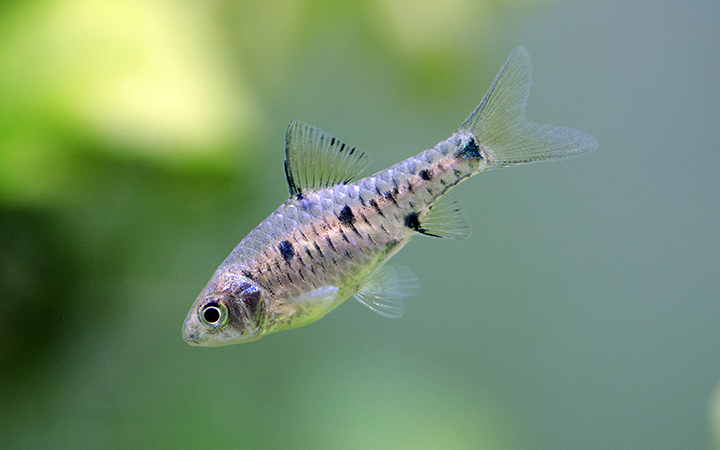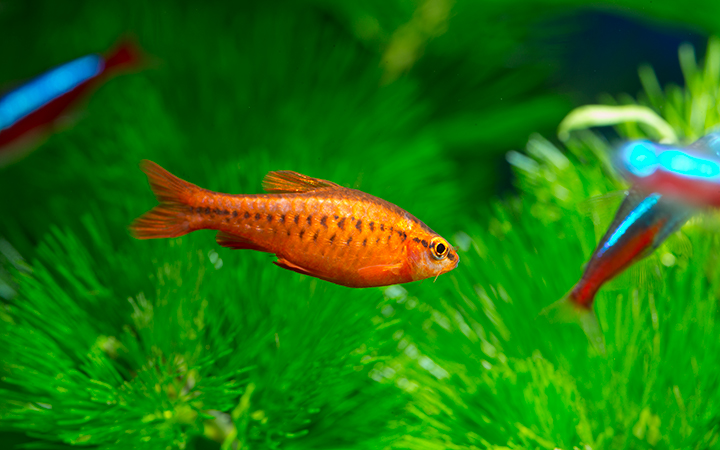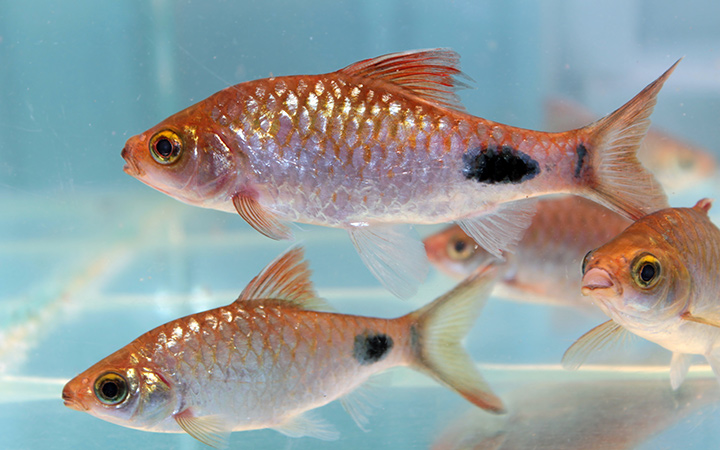In general, barbs are undemanding and active aquarium fish, but with so many suitable for aquaria you can’t keep them all – which ones have you kept?
Words: Steve Baker
There are 28 genera and over 500 species of ‘barb’, right up to the 3-meter-long, 660lb, Catlocarpio siamensis, known as the Siamese carp or Giant barb – the largest cyprinid (carp-like fish) in the world. Many are unavailable, like Caecobarbus geertsi, the endangered African blind barb from the Democratic Republic of the Congo.

However, there’s a large number of barbs that we can put in our tanks and personally, I think some of the most common species are hugely underrated fish.
The Chequered barb, Oliotius oligolepis, is an ideal aquarium fish – Small, hardy enough and completely non-aggressive. Colours may be subtle, but they’re beautiful in full adult colours.

Females display crescent markings on each scale – giving the ‘chequered’ effect – upon a silvery body. A hint of rosy-orange adorns the dorsal and anal fins of more mature females, but well-conditioned males show a deep rosy-orange and black out-lines in all fins other than the pectorals. The male’s body markings are more defined with greater coverage, and the base colour can display beautiful hues of blue, violet and pink.
They appreciate slightly cooler water (like many barbs) making them an excellent candidate for a smallish, tropical or unheated, aquarium – how many people start the hobby.

Common name: Chequered barb
Scientific name: Oliotius oligolepis
Pronunciation: Olly-oh-tee-us olly-go-lep-iss
Size: 4-4.5cm
Origin: Indonesia: thought to be endemic to northern Sumatra but their full distribution is uncertain.
Habitat: creeks, rivers and lakes.
Tank size: 60x30x37.5cm+
Water requirements: pH 5.5-7.5, 4-12°H
Temperature: 18-25°H
Temperament: calm and peaceful
Feeding: omnivore: flakes, micropellets and occasional small frozen foods.
Availability and cost: very common, from £1.75+
The Cherry barb, Puntius titteya, has similar attributes. They’re peaceful, small, hardy, inexpensive and happy in a tropical or unheated, indoor tank. Rather than underrated, the Cherry barb is kept and loved by many – I guess the colour makes a big difference. The fawn and red of the female is attractive, but the vivid red of mature males is stunning.

Different strains are available in the hobby. ‘Super-red’ females may look more like young males with red in their body. A ‘super red’ male shows off a deep, blood-red colour – uniform over body and fins.
Though known for its colour, a tank-bred albino strain has become popular. Females show little to no body colour with a hint of pinkie-red in the dorsal and anal fins. However, males still show body and fin pigment with mature specimens developing a bright pink lateral stripe leading to the pink iris of his eye.
In nature, they are endemic to small streams, deep within Sri Lankan rainforests. Substrates are of sand or gravel, often covered by leaf-litter. Due to agricultural habitat destruction, the dense ‘wet-zone’ forest of southwestern Sri Lanka is now majorly fragmented – leaving very few suitable streams.

Image: Cherry barb - Neil Hepworth.
Common name: Cherry barb
Scientific name: Puntius titteya
Pronunciation: pun-tee-us tit-tee-ya
Size: 4cm
Origin: Asia: southwestern Sri Lanka
Habitat: Shaded streams, deep within rainforests
Tank size: 60x30x37.5cm+
Water requirements: pH 6.0-7.8, 5-20°H
Temperature: 18-26°C
Temperament: calm and peaceful
Feeding: omnivore: naturally consumes detritus, algae and diatoms, small worms, crustaceans and plant matter. In aquaria, dried diets are happily accepted plus smaller live and frozen foods.
Availability and cost: very common, from £1.50
A personal favourite is the Black ruby barb, Pethia nigrofasciata. I once set up a cool-water, planted display tank with a mixture of barbs. Some took centre stage straight away with bright colours; the Ruby barbs became better week-on-week until they were my favourites of the collection.

As immature fish, they display a fawn-coloured body with dark, vertical bars. Females don’t change much other than developing a reticulated body pattern. Males go through stages. First, we see the dorsal, anal and pelvic fins darken while red pigment starts to show around the head. Next, the body darkens as the head becomes a deeper, ruby-red. Finally, the rear of the body darkens to black, fins become slightly extended, the deep red of the head blends into the body and the whole body is adorned by diamonds of reflective guanine crystals, helping disguise them from predators.
Again, numbers in the wild are pressured due to a mixture of habitat destruction and over-fishing for the ornamental market. They have been on the edge of extinction in the past; fortunately, populations are bouncing back since the Sri Lankan government banned their export, and conservation efforts have reaped their rewards.
Naturally, their diet and distribution are akin with the Cherry barb and commercially bred fish pose no difficulty to home and feed.
A larger, deeper body, robust nature and activity levels see a wider range of suitable tank mates compared to the above, smaller species. Larger rainbowfish and gouramis mix well as do less aggressive, small to medium-sized cichlids such as Gymnogeophagus, Crytoheros and Mesonauta spp.

Common name: Black ruby barb
Scientific name: Pethia nigrofasciata
Pronunciation: Peth-ee-ah nigro-fass-ee-ay-ta
Size: 6cm
Origin: Asia: Sri Lanka
Habitat: cool, clear and shaded forest streams and sometimes in marginal slack water of flowing rivers.
Tank size: 90x30x30+
Water requirements: pH 6.0-7.5, 5-12°H
Temperature: 22-27°C
Temperament: active, shoaling and generally peaceful.
Feeding: omnivore: naturally consumes detritus, algae and diatoms, worms, crustaceans and plant matter. In aquaria, dried diets are happily accepted as well as live and frozen foods.
Availability and cost: common, from £3.00
The Drape fin barbs, Oreichthys crenuchoides, aren’t hugely common nor are they particularly hard to find. This is another species that will repay you for your patients - when young they look like weak fish with ghostly colouration – it’s an unfair representation.

In mature fish, the body displays little in the way of colour. A silvery body is covered in a reticulated pattern, and a blush of yellow highlights the chin of males and females. The male also has a larger, delicate yellow patch behind the gill. While the dorsal fin of both sexes displays deeper yellow, it’s the male that steals the show. His large, extended dorsal fin is where the common name comes from, draped when not in play but, when displaying to a female, the erect fin makes for a stunning courtship show.
Unlike most barbs, this is a relatively inactive species with a shy nature. Tankmates should be small and gentle such as Ember tetras, Hyphessobrycon amandae, Sparkling gouramis, Trichopsis pumila, or the Lambchop rasbora, Trigonostigma espei. Though shy toward other fish, male Drape fins are rather competitive toward one another, for this reason, a shoal should have a female bias.
Otherwise, the drape fin barb is an undemanding aquarium fish which is adaptable to water conditions, if extremes are avoided, and is easy to feed. They’re also more at home in brightly-lit aquaria than many barbs – their natural habitat is relatively clear and slow-flowing streams and rivers running through open grassland.

Common name: Drape fin barb
Scientific name: Oreichthys crenuchoides
Pronunciation: Or-ick-th-iss kre-new-koi-dees
Size: 3-4cm
Origin: India: West Bengal state
Habitat: Slow-moving streams and rivers with a muddy substrate
Tank size: 60x30x30cm+
Water requirements: pH 6.0-7.5, 4-15°H
Temperature: 23-28°C
Temperament: delicate shoaling fish, males compete heavily
Feeding: omnivore: In aquaria dried diets are happily accepted as well as smaller live and frozen foods.
Availability and cost: you may have to search for them, around £4.50
Finally, the Filament barb, Dawkinsia filamentosa. It’s a fish that, like myself, you’ve probably passed by on numerous occasions in a shop setting, but the wow factor of a group of mature specimens is an eye-opener.

Robust, they certainly are. Their lean, muscular bodies and strong, forked tailfin allow them to swim tirelessly in larger, lowland rivers. That makes them a barb for larger aquaria, with a good amount of open swimming space. Sometimes found in brackish waters, these are adaptable fish – as long as conditions don’t get too hard. Good water quality is required as they don’t fare well with a build-up of organic pollutants. Strong aeration should also be supplied, but a powerful flow is not a necessity.
In nature they co-habit with other barbs such as the Rosy barb, Pethia conchonius, Denison’s barbs, Puntius denisonii, Mellon barbs, Haludaria fasciata and the closely related Mascara barb, Dawkinsia assimilis. In home aquaria they’re well suited to mixing with larger, mainly peaceful species such as Severum cichlids, Heros spp. Geophagus spp. and mid-sized catfish and plecs. Other good-sized shoaling fish like Silver dollars, Metynnis spp., larger rasboras like Elegant and scissortail rasboras and flying foxes from the genus Crossocheilus.

Common name: Filament barb
Scientific name: Dawkinsia filamentosa
Pronunciation: Door-kin-see-ah filament-oh-sa
Size: 10-12cm
Origin: Southern India: endemic to the Western Ghats.
Habitat: lowland coastal floodplains, sometimes found in brackish waters.
Tank size: 150x45x45cm+
Water requirements: pH 6.0-7.5, 5-15°H
Temperature: 20-25°C
Temperament: peaceful shoaling species.
Feeding: naturally consumes detritus, worms, crustaceans and plant matter. In aquaria dried diets are happily accepted as well as live and frozen foods.
Availability and cost: not rare but you may have to search for them a little, around £15.








